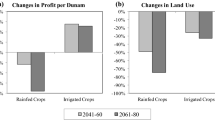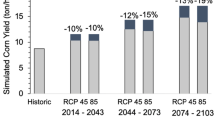Abstract
The climate of the 1930s was used as an analog of the climate that might occur in Missouri, Iowa, Nebraska and Kansas (the MINK region) as a consequence of global warming. The analog climate was imposed on the agriculture of the region under technological and economic conditions prevailing in 1984/87 and again under a scenario of conditions that might prevail in 2030. The EPIC model of Williamset al. (1984), modified to allow consideration of the yield enhancing effects of CO2 enrichment, was used to evaluate the impacts of the analog climate on the productivity and water use of some 50 representative farm enterprises. Before farm level adjustments and adaptations to the changed climate, and absent CO2 enrichment (from 350 to 450 ppm), production of corn, sorghum and soybeans was depressed by the analog climate in about the same percent under both current and 2030 conditions. Production of dryland wheat was unaffected. Irrigated wheat production actually increased. Farm level adjustments using low-cost currently available technologies, combined with CO2 enrichment, eliminated about 80% of the negative impact of the analog climate on 1984/87 baseline crop production. The same farm level adjustments, plus new technologies developed in response to the analog climate, when combined with CO2 enrichment, converted the negative impact on 2030 crop production to a small increase. The analog climate would have little direct effect on animal production in MINK. The effect, if any, would be by way of the impact on production of feed-grains and soybeans. Since this impact would be small after on-farm adjustments and CO2 enrichment, animal production in MINK would be little affected by the analog climate.
Similar content being viewed by others
References
Adams, R. M., Rosenzweig, C., Peart, R. M., Richie, J. T., McCarl, B. A., Glyer, J. D., and Curry, R. B.: 1990, ‘Global Climate Change and U.S. Agriculture’,Nature 345, 219–224.
Agricultural Economics Extension Staff: 1988,Estimated Crop and Livestock Production Costs Nebraska, EC 88-872, Nebraska Cooperative Extension Service, University of Nebraska, Lincoln, revised 1988.
Azzam, A., Yanagida, J., and Linsenmeyer, D.: 1987, ‘A Linked Econometric Model of the Livestock-Feed Sectors in Nebraska and the Rest of the United States’,North Central J. Agricult. Econom. 9, 247–258.
Bach, W.: 1979, ‘The Impact of Increasing Atmospheric CO2 Concentrations on the Global Climate: Potential Consequences and Corrective Measures’,Environm. Internat. 2, 215–228.
Byrkett, D., Miller, R., and Taiganides, E. P.: 1976, ‘Modeling the Optimal Location of the Cattle Feeding Industry’,Amer. J. Agric. Econ. 58, 236–244.
Crosson, P. R.: 1989, ‘Climate Change and Mid-Latitudes Agriculture: Perspectives on Consequences and Policy Responses’,Clim. Change 15, 51–73.
Crosson, P. R.: 1991, (review of Parry, M.L.: 1990, ‘Climate Change and World Agriculture’.)Food Policy 16 (6), 498–499.
Crosson, P. R. and Katz, L. A., with Wingard, J.: 1991,Processes for Identifying Regional Influences of and Response to Increasing Atmospheric CO 2 and Climate Change - The MINK Project, Report IIA- Agricultural Production and Resource Use in the MINK Region without and with Climate Change, DOE/RL/01830T-H7 [TR052C], 123 pp.
Easterling, W. E., McKenney, M., Rosenberg, N. J., and Lemon, K. M.: 1991,Processes for Identifying Regional Influences of and Responses to Increasing Atmospheric CO 2 and Climate Change - The MINK Project, Report IIB - A Farm-Level Simulation of the Effects of Climate Change on Crop Production in the MINK Region, DOE/RL/01830T-H8 [TR052D], 222 pp.
Easterling, W. E., Rosenberg, N. J., McKenney, M. S., Jones, C. A., Dyke, P. T., and Williams, J. R., 1992, ‘Preparing the Erosion Productivity Impact Calculator (EPIC) Model to Simulate Crop Response to Climate Change and the Direct Effects of CO2’,Agricultural and Forest Meteorology, Special Issue: Methods for Assessing Regional Agricultural Consequences of Climate Change59, no. 1 & 2, 17–34.
Eck, H. V.: 1986, ‘Effects of Water Deficits on Yield, Yield Components, and Water Use Efficiency of Irrigated Corn’,Agron. J. 78, 1035–1040.
English, B., Maetzold, J., Holding, B., and Heady, E.: 1984,Future Agricultural Technology and Resource Conservation, Iowa State University Press, Ames.
Fausett, M. and Barnaby, Jr., G.: 1988,Beef Cowherd, KSU farm management guide MF 266, Department of Agricultural Economics, Kansas State University, Manhattan, revised, August.
Frederick, K. D.: 1991,Processes for Identifying Regional Influences of and Responses to Increasing Atmospheric CO 2 and Climate Change - The MINK Project, Report IV - Water Resources, DOE/RL/01830T-H10 [TR052F], 153 pp.
Iowa State University: 1988,1987 Iowa Farm Costs and Returns, RM-1789, Iowa State University Extension, Ames, revised, December.
Jacobs, V. E.: 1988,Missouri MIR 1987 Cow-Calf Returns, Farm management newsletter, University Extension, Department of Agricultural Economics, University of Missouri, Columbia, December 27.
Johnson, G. L. and Wittwer, S. H.: 1984,Agriculture Technology Until 2030: Prospects, Priorities, and Policies, Michigan State University, Agriculture Experiment Station, Special Report 12.
Kimball, B. A.: 1983,Carbon Dioxide and Agricultural Yield: An Assemblage and Analysis of 770 Prior Observations, Water Conservation Laboratory, Report No. 14, USDA/ARS, Phoenix, AZ.
McKenney, M. S., Easterling, W. E., and Rosenberg, N. J.: 1992, ‘Simulation of Crop Productivity and Responses to Climate Change in the Year 2030: The Role of Future Technologies, Adjustments, and Adaptations’,Agricultural and Forest Meteorology, Special Issue: Methods for Assessing Regional Agricultural Consequences of Climate Change59, no. 1 & 2, 103–127.
Monteith, J. L.: 1965, ‘Evaporation and Environment’,Symp. Soc. Exp. Biol. 19, 203–234.
Morison, J. I. L.: 1987, ‘Intercellular CO2 Concentration and Stomatal Response to CO2’, in Ziegler, E., Farguhar, G. D., and Cowan, I. P. (eds.),Stomatal Function, Stanford University Press, Palo Alto, CA.
Newman, J. E.: 1982, ‘Impacts of Rising Atmospheric Carbon Dioxide Levels on Agricultural Growing Seasons and Crop Water Use Efficiencies’, Vol. II, Part 8 ofEnvironmental and Social Consequences of a Possible CO 2-Induced Climate Change, Carbon Dioxide Research Division, Dept. of Energy, Washington, D.C.
Office of Technology Assessment: 1986,Technology, Public Policy and the Changing Structure of American Agriculture, OTA-F-285, NTIS, Washington, D.C., 374 pp.
Otte, C. and Fruin, J.: 1989,Trends in the Minnesota, United States and World Soybean Industry, Staff paper P89-43, Department of Agricultural and Applied Economics, University of Minnesota, St. Paul.
Parry, M. L.: 1990,Climate Change and World Agriculture, Earthscan Publications, London.
Parry, M. L. and Carter, T. R.: 1988, ‘The Assessment of the Effects of Climatic Variations on Agriculture: Aims, Methods and Summary of Results’, in Parry, M. L., Carter, T. R., and Konijn, N. T. (eds.),The Impact of Climate Variations on Agriculture, Volume 1, Assessments in Cool Temperate and Cold Regions, Kluwer, Dordrecht, The Netherlands, pp. 11–96.
Retta, A. and Hanks, R. J.: 1980, ‘Corn and Alfalfa Production as Influenced by Limited Irrigation’,Irrig. Sci. 1, 135–147.
Rosenberg, N. J., McKenney, M. S., Easterling, W. E., and Lemon, K. M.: 1992, ‘Validation of EPIC Model Simulations of Crop Responses to Current Climate and CO2 Conditions: Comparisons with Census, Expert Judgment and Experimental Plot Data’,Agricultural and Forest Meteorology Special Issue: Methods for Assessing Regional Agricultural Consequences of Climate Change59, no. 1 & 2, 35–51.
Rosenzweig, C.: 1985, ‘Potential COa-Induced Effects on North American Wheat Producing Regions’,Climatic Change 7, 367–389.
Ruttan, V. W.: 1989,Biological and Technical Constraints on Crop and Animal Productivity: Report on a Dialogue, University of Minnesota, Inst. of Agriculture, Forestry and Home Economics, St. Paul, Staff paper P-89-45.
Sanderson, F.: 1988, ‘The Agro-Food Filiére: A Macroeconomic Study on the Evolution of the Demand Structure and Induced Changes in the Destination of Agricultural Outputs’, in Antonelli, G. and Quadrio-Curzio, A. (eds.),The Agro-Technological System towards 2000: A European Perspective, Elsevier Science Publishers, The Netherlands.
Smith, J. B. and Tirpak, D. (eds.): 1989,The Potential Effects of Global Climate Change on the United States, United States Environmental Protection Agency, Office of Policy, Planning, and Evaluation, Washington, D.C.
Stockle, C. O. and Kiniry, J. R.: 1991, ‘Variability in Crop Radiation Use Efficiency Associated with Vapor Pressure Deficit’,Field Crop Res. 25 (in press).
Stockle, C. O., Williams, J. R., Rosenberg, N. J., and Jones, C. A.: 1992a, ‘Estimating the Effect of Carbon Dioxide-Induced Climate Change on Growth and Yield of Crops', I. Modification to the EPIC Model for Climate Change Analysis’,Agricult. Syst. (in press).
Stockle, C. O., Dyke, P. T., Williams, J. R., Jones, C. A., and Rosenberg, N. J.: 1992b, ‘Estimation of the Effects of CO2-Induced Climate Change on Growth and Yield of Crops. II. Assessing the Impacts on Maize, Wheat and Soybean in the Midwestern U.S.A.’,Agricult. Syst. (in press).
U.S. Congress, Office of Technology Assessment: 1986,Technology, Public Policy, and the Changing Structure of American Agriculture, OTA-F-285, U.S. Govt. Print. Office, Washington, D.C.
U.S. Department of Agriculture: 1974,Agricultural Statistics 1974, USDA, U.S. Govt. Printing Office, Washington, D.C.
U.S. Department of Agriculture: 1980,Agricultural Statistics 1980, USDA, U.S. Govt. Printing Office, Washington, D.C.
U.S. Department of Agriculture: 1985,Agricultural Statistics 1985, USDA, U.S. Govt. Printing Office, Washington, D.C.
U.S. Department of Agriculture: 1988,Agricultural Statistics 1987, USDA, U.S. Govt. Printing Office, Washington, D.C.
U.S. Department of Agriculture: 1989a,Agricultural Statistics 1988, USDA, U.S. Govt. Printing Office, Washington, D.C.
U.S. Department of Agriculture: 1989b,Economic Indicators of the Farm Sector: Costs of Production 1987, USDA-ERS, Report ECIFS 7-3, U.S. Govt. Printing Office, Washington, D.C.
U.S. Department of Agriculture: 1990,World Grain Situation and Outlook, Foreign Agricultural Service, Circular Series, FG 3-90, Washington, D.C., March.
U.S. Department of Agriculture, Soil Conservation Service: 1981,Land Resource Regions and Major Land Resource Areas of the United States, Agriculture handbook 296, USDA, U.S. Govt. Printing Office, Washington, D.C.
U.S. Department of Commerce: 1990,Regional Projections to 2040, Vol. 1: States, Bureau of Economic Analysis, Washington, D.C.
Williams, J. R., Jones, C. A., and Dyke, P. T.: 1984, ‘A Modeling Approach to Determining the Relationship between Erosion and Soil Productivity’,Trans. Amer. Soc. Agri. Engin. 27, 129–144.
World Bank: 1986,Commodity Trade and Price Trends, Johns Hopkins University Press, Baltimore.
Author information
Authors and Affiliations
Rights and permissions
About this article
Cite this article
Easterling, W.E., Crosson, P.R., Rosenberg, N.J. et al. Paper 2. agricultural impacts of and responses to climate change in the Missouri-Iowa-Nebraska-Kansas (MINK) region. Climatic Change 24, 23–61 (1993). https://doi.org/10.1007/BF01091476
Received:
Revised:
Issue Date:
DOI: https://doi.org/10.1007/BF01091476




